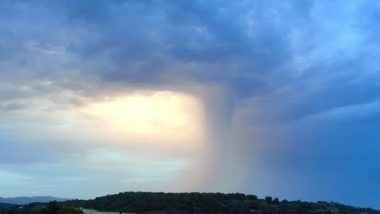New Delhi, July 12: Several states in India have been experiencing cloudbursts that are triggered by incessant rainfall, especially in the hilly regions including Uttarakhand, Himachal Pradesh, Jammu and Kashmir among others. A cloudburst is a sudden fierce downpour within a radius of a couple of kilometers. Historically, cloudbursts usually do not last for more than a few minutes, however, they are capable of flooding the entire area in no time.
As per reports, rainfall from a cloudburst is usually equal to or greater than 100 mm per hour. The occurrence of cloudbursts is commonly seen across the mountainous regions, deserts, and interior regions of continental landmasses. Majorly, all recorded cloudbursts are experienced in the Indian subcontinent where monsoon clouds drift from the Bay of Bengal or the Arabian Sea onto the Himalayas. Flash Floods in Dharamshala After Cloudburst: Heavy Rainfall Wreaks Havoc in Bhagsu Nag (Watch Videos).
What is a Cloudburst?
Cloudburst is a sudden copious rainfall that occurs for a short period of time-limited in a small area. As per meteorologists, the rain from a cloudburst is usually of the shower type with a fall rate equal to or greater than 100 mm (4.94 inches) per hour. A cloudburst is sometimes accompanied by hail and thunder, which is capable of creating flood conditions. Cloudbursts are infrequent as they occur only via the 'orographic lift' or occasionally when a warm air parcel mixes with cooler air, resulting in sudden condensation.
The term 'cloudburst' was coined from the notion that clouds were akin to water balloons and could burst, resulting in rapid precipitation. Though this idea has since been disproven, the term remains in use. During a cloudburst, more than 20 millimetres (0.79 in) of rain may fall in a few minutes. The results of cloudbursts can be disastrous. Cloudbursts are also responsible for flash flood creation.
What Happens During a Cloudburst?
A Cloudburst usually occurs in high-altitude areas due to the formation of a low-pressure area on the top of a mountain. The low-pressure zone attracts clouds to the top of the mountain with great force. When they hit the peak, the moisture content is released in the form of rain. All heavy rains are not necessarily cloudbursts. On the amount of rain involved, a cloudburst can be quite dangerous, especially if it lasts for several hours.
Cloudburst Process- How Does it Happen?
Cloudbursts occur as the warm air current from the ground or below the clouds rush upwards. While it moves up, it carries the falling raindrops up with it. As the rainfall fails to fall down, it results in excessive condensation in the clouds as new drops form and old drops are pushed back into it due to the conversion process. The air current slows down resulting a violent downpour in a region.
The severity of the cloudbursts differs based on terrain. When it occurs in the mountains, large volumes of water gain momentum as it flows in gushes, resulting in landslides. In the plains, cloudbursts cause waterlogging and flash floods. Mostly, cloudbursts are accompanied by lightning, thunder, strong gusts of wind and hail storms. In the Indian subcontinent, a cloudburst usually occurs when a monsoon cloud drifts northwards, from the Bay of Bengal or Arabian Sea across the plains, then onto the Himalayas and bursts, bringing rainfall as high as 75 millimetres per hour.
Cloudbursts can be dangerous and can also prove fatal as they have the capacity to trigger flash floods in no time depending on the amount of rainfall in the region. The most disastrous cloudburst was reported in India in the year 2013, in which at least 5,400 people were killed and affected 4,200 villages.
In June, a study found a connection between cloudburst and forest fires and stated that the formation of tiny particles, the size of a cloud droplet on which water vapour condenses leading to the formation of clouds and forest fires. The study informed that the number of such particles called the cloud condensation nuclei (CCNs) were found to have peaks associated with forest fire events.
(The above story first appeared on LatestLY on Jul 12, 2021 01:19 PM IST. For more news and updates on politics, world, sports, entertainment and lifestyle, log on to our website latestly.com).













 Quickly
Quickly











